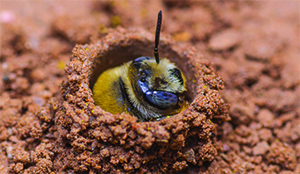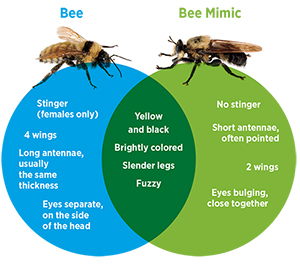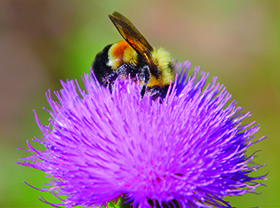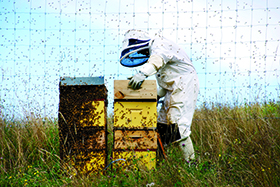
Audubon Adventures

Background for Teachers
Bees belong to the insect order Hymenoptera, which means “membrane-winged,” along with ants, sawflies, and wasps. These insects possess two pairs of wings, a distinct “waist,” and mouthparts adapted for biting or chewing. Bees are distinguished by their branched body hairs, helpful in trapping pollen grains, and their wide leg segments.
 Bee Types
Bee Types
The estimated 4,000 species of bees native to North American range in size from carpenter bees that are over an inch long to tiny Perdita bees that barely reach 1/16 of an inch. Most are black or brown with yellow, orange, white, or pearl-colored markings. Others shimmer in metallic green or blue. Some are furry, others almost hairless. Nonnative honey bees look much like some native bees, and it’s often difficult to tell them apart, especially to the untrained observer.
Common names of bees reflect nesting styles and other behaviors. Carpenter, mason, plasterer, leafcutter, digger, and polyester bees are named for females’ nest-building techniques, and orchard, gourd, and alkali bees are named for their preferred habitat. Sweat bees are attracted to human perspiration, which they lap up for the salt. Bumble bees’ wings hum as they fly. Cuckoo bees lay their eggs in other bees’ nests.
Bee-ing Solitary
Most native bee species are solitary, each female building and provisioning individual nest chambers where her young grow up on their own. Some solitary bees build nests near others of their same species—alkali bees, for instance, dig nest burrows in “bee beds” near hundreds or thousands of others. But each individual nest is constructed by a single female working alone. A solitary bee larva hatches, eats, and grows in its brood chamber, nourished by a ball of pollen mixed with some nectar, left by its mother. At metamorphosis, the body of the wingless, legless larva re-forms into a winged adult bee. The adult bee may emerge immediately or wait until environmental cues tell it when flowers are likely to be in bloom.
Male solitary bees live to reproduce. They mate with as many females as possible during their brief, several-day to several-week adult life. Female solitary bees live long enough to build nests and provide for the next generation.
 Solitary bees dig nests in bare soil, chew tunnels in dead wood or the pith of plant stems, or remodel abandoned rodent nests or beetle tunnels into many-chambered complexes, each chamber holding a single egg. Plasterer and mason bees line brood chamber walls with a waterproof cellophane- or plastic-like substance secreted from their bodies. Leafcutter bees use leaves as partitions between cells, while mason bees use mud. Wool carder bees collect hairs from plant stems to line their egg cells.
Solitary bees dig nests in bare soil, chew tunnels in dead wood or the pith of plant stems, or remodel abandoned rodent nests or beetle tunnels into many-chambered complexes, each chamber holding a single egg. Plasterer and mason bees line brood chamber walls with a waterproof cellophane- or plastic-like substance secreted from their bodies. Leafcutter bees use leaves as partitions between cells, while mason bees use mud. Wool carder bees collect hairs from plant stems to line their egg cells.
Bee-ing Social
Social bees live in colonies comprised of two to hundreds of adult females that share the work of building the nest and raising young. Native social bees include big, fuzzy bumble bees and tiny, metallic sweat bees.
Read more.Native bee colonies tend to be annual—they survive just one season, unlike multi-year colonies of nonnative honey bees. (In tropical and subtropical regions, however, colonies can live through the year.) Taking bumble bees as an example of a native social bee’s life cycle, an individual queen emerges in spring and, after locating a nest site, builds a cluster of brood chambers, lays eggs, and then tends the first generation of larvae. When the adult bees—all female—emerge four to five weeks later, these workers maintain and enlarge the nest, gather food, and tend the queen and subsequent generations of young.
In late summer, the queen lays a special batch of eggs that produce both males (from unfertilized eggs) and fertile females (from fertilized eggs). Once mature, the males and females mate, after which most of the colony dies. Only newly mated females—now queens—survive to establish new colonies the following spring. (Note that separate colonies launch their males and new queens at the same time to ensure genetic diversity from cross-breeding.)
Bee-ing Parasitic
Some bee species are parasitic and don’t build nests at all. These bees often lay eggs in the nests of other related species. Cuckoo bees parasitize solitary bees by laying eggs in their host’s brood chambers. Their larva kills the host bee’s egg or larva and then eats its food. Female bees that parasitize social bee species trick the colony into raising their young by either killing the colony’s existing queen or hiding in the nest until they acquire the colony’s distinctive smell and can move in alongside the existing queen without a fight.
Which Bees Are Stingers?
Only female bees sting: Their stinger is modified from their egg-laying tube. All bees on flowers are busy foraging and will not sting unless disturbed. If a honey bee colony is disturbed at the nest entrance, they may sting to defend themselves. Africanized bees, a form of nonnative honey bees, are the most aggressive.
Bees and Flowers: Partners for Life
Bees and many flowering plants have a tight relationship: Flowers provide bees’ food; bees pollinate the flowers, allowing the plants to reproduce. Adult bees live on sugar-laden flower nectar and gather fat- and protein-rich pollen to feed their young.
Bee feeding preferences vary. Short-tongued bees prefer open flowers such as sunflowers, asters, mallows, and cactus. Long-tongued bees can reach into deep flowers like lupines, columbines, and orchids. Short-tongued bees that are small enough to crawl all the way inside can also get nectar from these deep flowers.
Many bee species, including all social bees, are generalists, foraging from any open blossoms. Some species, such as squash bees, stick to flowers of just one family or group of species—in this case, squashes and pumpkins. A few, including the tiny Mojave bee, are extremely picky eaters and rely solely on one species of flower. All native bees display “flower constancy,” foraging efficiently by concentrating on one flower species during each foraging flight.
This tendency to stick with one type of flower is what makes native bees so important as pollinators. Since plants are rooted in place, they need help moving their pollen, the male sexual cells, from one plant to the next in order to fertilize their flowers and produce seeds, which are embryonic plants. (Some species can self-pollinate, but cross-pollination results in more abundant and more successful offspring.)
Most flowering plants rely on animal partners to carry their pollen from flower to flower, though some, including cone-bearing trees and grasses, use the wind. (These plants’ pollen causes most respiratory allergies.) To attract animal partners, plants produce bright-colored, easily visible blossoms, enticing fragrances, and nectar. Their pollen grains sport bumps and prickles that adhere to their partners’ bodies, aided by a static charge on the bees’ hairs.
Bees are the most important group of animal pollinators because they deliberately gather pollen. A female bee on a single foraging flight may visit thousands of flowers, in the process dusting each with pollen from other blossoms of the same species. Some help bees by signaling when a particular blossom has been pollinated: The petals change color or fold up.
Biologists consider native bees keystone species because so many other species depend on these insects. Without bees, native flowering plant populations decline, as do birds and other animals that eat bees. Without the plants, whole ecosystems fall apart: Animals and birds lose food and shelter and soil erodes, degrading water and air quality as well. When native bee populations are endangered, that’s a sign that ecosystems and the humans that depend on them are also in trouble.
People can help native bees by minimizing pesticide use, putting up and maintaining bee boxes and bundles, and landscaping with bees in mind to restore habitat in backyards, parks, golf courses, farms, and wild areas.
Photos: (top to bottom) Dan Mullens; (3 bees) Clay Bolt; Jasper Nance/Flickr CC BY-NC-ND 2.0







 On a bee-to-bee basis, native bees pollinate some crops more efficiently than nonnative honey bees. Buzz pollination by native bumble bees, for instance, results in more abundant and better-shaped tomatoes. In one acre of apple orchard, 250 native blue mason bees do the work of 30,000 to 40,000 honey bees. A female alkali bee not only can pollinate 2,000 alfalfa blossoms a day, she can also “trip” the flower to signal that it has been pollinated. However, honey bees are still vital to our agricultural system because their colonies containing large populations can be easily transported to locations where their pollination services are needed.
On a bee-to-bee basis, native bees pollinate some crops more efficiently than nonnative honey bees. Buzz pollination by native bumble bees, for instance, results in more abundant and better-shaped tomatoes. In one acre of apple orchard, 250 native blue mason bees do the work of 30,000 to 40,000 honey bees. A female alkali bee not only can pollinate 2,000 alfalfa blossoms a day, she can also “trip” the flower to signal that it has been pollinated. However, honey bees are still vital to our agricultural system because their colonies containing large populations can be easily transported to locations where their pollination services are needed.